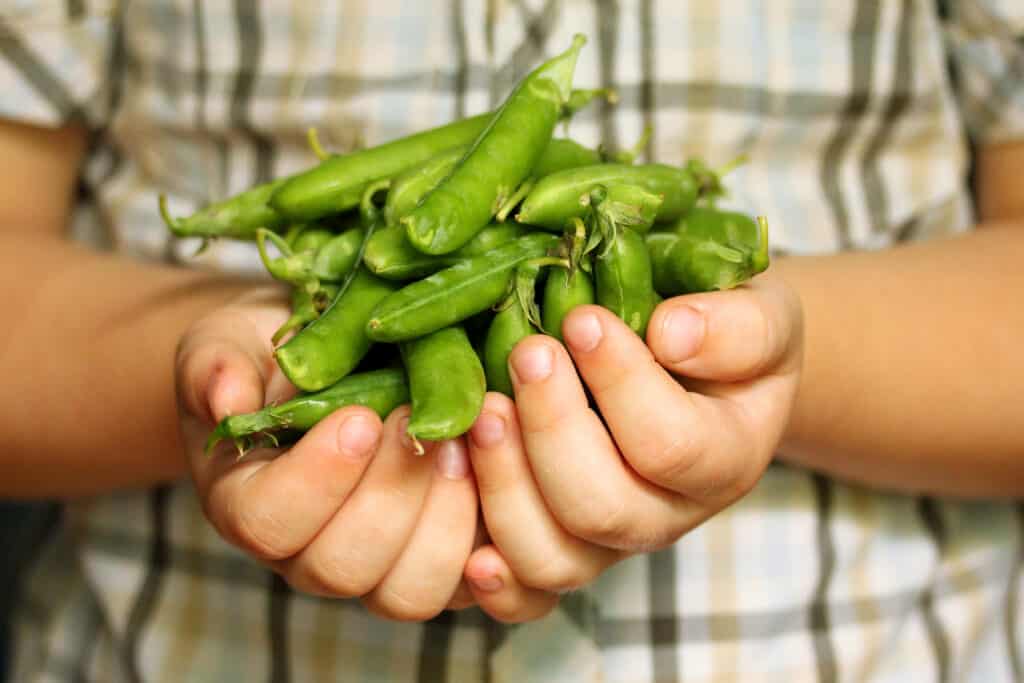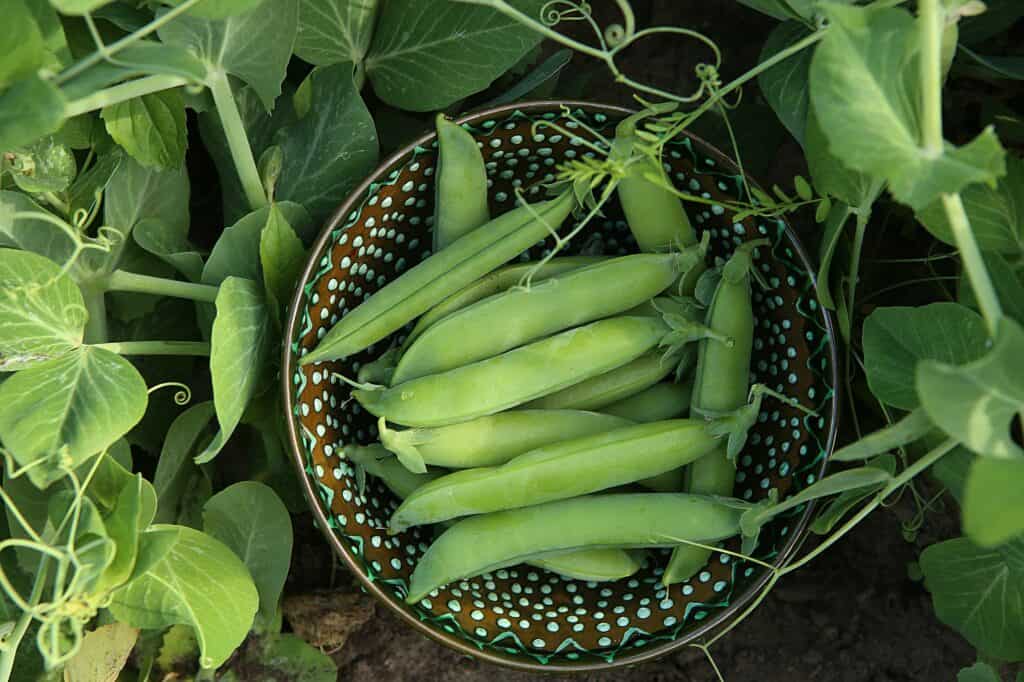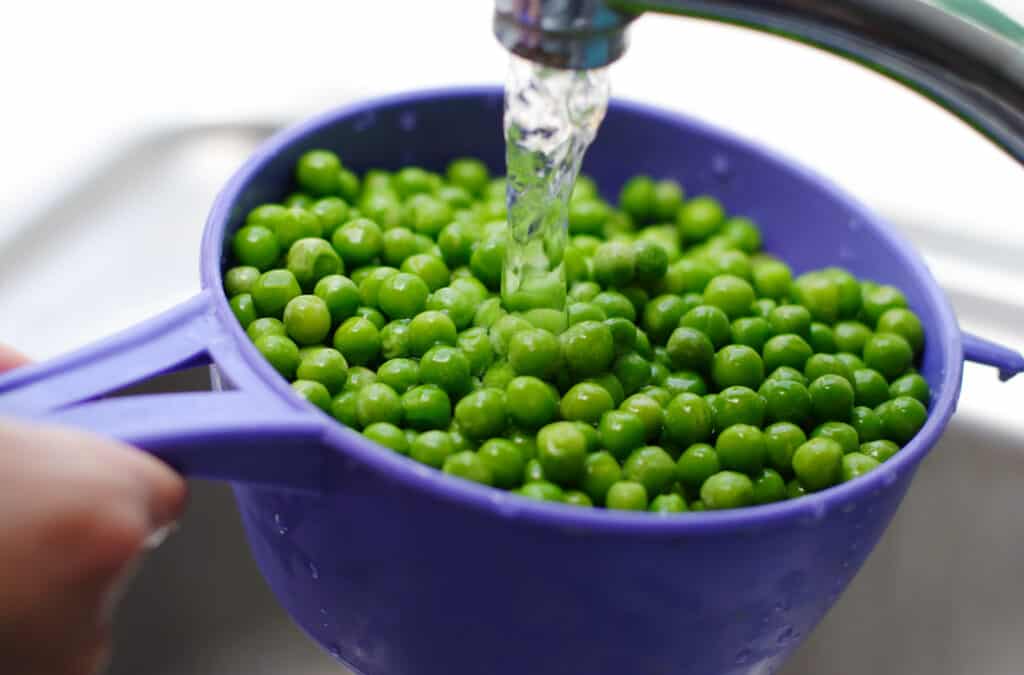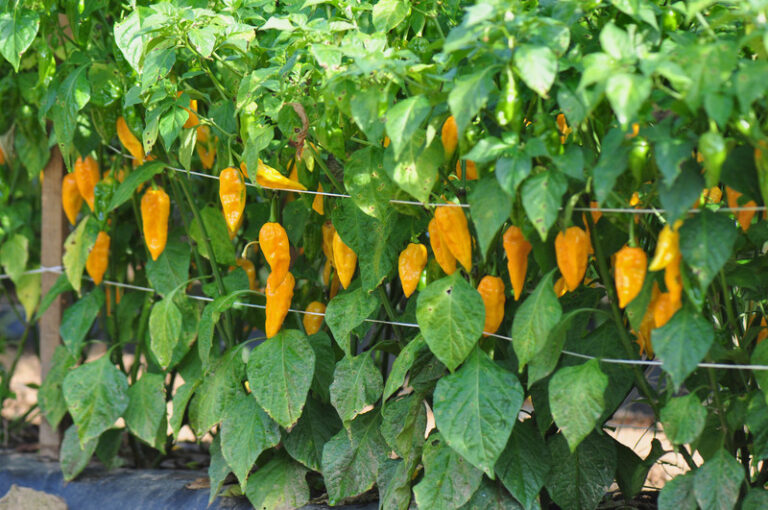How to Harvest and Store Peas
Harvest green peas when they are young and tender. They will become hard and starchy if left on the vine for too long. Green peas are best shelled and cooked within an hour of harvest.
Harvest edible-pod peas when the peas are just beginning to form; when the outline of the pea is just visible in the pod.

Types of peas
There are three kinds of peas: garden peas, snap peas, and snow peas.
- Green peas, also called garden peas and English peas or green peas, are the peas you eat without a pod. There are two kinds of green peas—the small-seeded type, also called petit pois, for eating fresh and freezing, and the large-seeded type which is shelled and used as dry peas; large-seeded peas are also called soup peas.
- Snap peas, sometimes called sugar snap peas, are tender, sweet, and can be eaten pod and all.
- Snow peas, also called Chinese peas or Asian peas, or sugar peas, also can be eaten pods and all.

When to harvest peas
- Peas will be ready for harvest 55 to 70 days after sowing.
- Grow peas to maturity in late spring or early summer and in autumn—when temperatures are in the 60°s to 70°sF (15°+–21°+C). Peas must mature before the weather gets hot.
- Harvest garden or shelling peas when the pods are fully developed but still bright green. Before picking, taste garden peas for sweetness—taste them every day after the pods have begun to fill. They should be sweet and tender and slightly larger than the dry seed you planted. Don’t wait too long; once garden peas reach maturity they rapidly decline in quality, start to yellow, and become inedible as fresh peas within one to three days.
- Garden peas picked too soon will lack sweetness. Over mature peas will be starchy and have tough skins. If you wait too long and peas begin to yellow and the pods become tough, leave them to dry on the vine and use them as dry, soup peas.
- Peas for shelling should be shelled immediately after picking or cooled immediately after picking—submerge them in cold water—for shelling later. Shelled peas are most flavorful and eaten soon after harvest—otherwise, the quality declines rapidly.
- Harvest sugar snap peas any time after peas begin to form in the pod and continue picking until the pods are fully elongated, about 3 inches (7 cm) long. Sugar snap peas are most flavorful if picked at about half full size, about a week after flowering. Both the peas and the pods will be very sweet.
- Harvest edible-pod snow peas or Asian peas while pods are immature and still flat—before the seeds begin to fill out. Harvest snow peas every other day to keep pods from getting too big. Snow peas that get too large will be tough. Some snow pea varieties have fibrous string along the edges of the pods; remove the strings before cooking. Snow peas can be eaten whole pod and all or shelled just like garden peas.
- Harvest pea shoots or tendrils (used for stir-fries or steaming) when shoots are about 6 inches (15 cm) long. Cut the shoots from the vine. Edible-pod pea varieties have the tastiest shoots. Shoots that are leafless are usually tender and sweeter than leafy shoots.
- English peas mature more rapidly in the pod than sugar snap and snow peas. It’s always best to check peas every day or two to know exactly when to pick.

How to harvest peas
- Pick peas with two hands. Secure the vine with one hand then pinch the stem of each pod and pull with the other hand. Don’t tug or jerk pods away; pea plants hang on to their support with thin tendrils so a heavy hand can dislodge the plant from its support.
- Pick peas in the morning after the dew has dried. That is when they will be crisp and crunchy for fresh eating.
- Peas must be promptly cooled to maintain freshness and to preserve sugar content (the sugar in peas quickly turns to starch after harvest unless cooled). Cooled peas will hold their quality for more than a week in the refrigerator.
- Remove garden or field heat from peas after picking by dunking them in a cold water bath until pods are chilled then dry and refrigerate.
- Keep plants well-picked to encourage more pods to develop. If you miss the peak harvest (check the days to maturity), you can still pick, dry, and shell peas for use in winter soups. Quality for fresh eating, declines rapidly once maturity is reached.

How to store peas
- Eat peas as soon after picking as possible; the sugar that makes peas sweet begins turning to starch right after picking.
- Store peas cold and moist, 32°-40°F (0°-4°C) and 95 percent relative humidity. Cold and moist storage is a challenge to create. Refrigerators provide the cold, but they also dry the air.
- Place peas in a perforated plastic bag in the vegetable crisper section of the refrigerator to keep them moist.
- Peas will keep in the refrigerator for 5 to 7 days.
- Peas that can’t be used in a week should be frozen.
- Peas that are stored too cold or too long will become soft and start to brown.
Peas Growing Hub
Start here: The Ultimate Peas Growing Guide: From Seed to Harvest
Pea Basics & Types
- Different Types of Peas: Garden, Snap, and Snow Compared
- Round Peas vs. Wrinkled Peas: What’s the Difference?
- Best Pea Varieties to Grow for Flavor and Yield
- Garden Peas vs. Field Peas: Growing and Cooking Differences
- Snap Peas vs. Snow Peas: Which Should You Grow?
Planting & Site Prep
- When to Plant Peas by USDA Zone
- Peas Seed Starting Tips
- How to Plant Peas for a Fall Harvest
- Inoculating Pea Seeds: Why and How to Do It
- Planting Peas in Wide Rows or Blocks for Maximum Yield
- How to Plant Peas in Twin Furrows
- Bush Peas vs. Pole Peas: Which Is Best for Your Garden?
- Support Systems for Peas: Stakes, Trellises, and Netting Explained
- How to Grow Peas in Containers
- The Best Companion Plants for Peas
Care & Maintenance
- How to Water Peas for Steady Growth
- Fertilizing Peas Naturally: Boosting Growth Without Overfeeding
- Caring for Pea Vines Throughout the Growing Season
Pollination, Pests & Diseases
- How Pea Pollination Works and Tips for Seed Saving
- Common Pea Pests and Disease and Their Natural Control
- How to Protect Peas from Birds
Harvest & Beyond
- How to Harvest and Store Peas
- How to Cook and Serve Garden and Snap Peas
- How to Cook and Serve Snow Peas
- How to Prepare Spring Peas with No Recipe
Peas rlated articles on Harvest to Table:
How to Cook and Serve Garden and Snap Peas
How to Prepare Spring Peas with No Recipe
English Peas, Spring Onions, and Roasted Almonds
Baby Beets, Baby Carrots, and Sugar Snap Peas Salad
How to Cook and Serve Snow Peas
Garden Planning Books at Amazon:
- Vegetable Garden Almanac & Planner
- Kitchen Garden Grower’s Guide Vegetable Encyclopedia
- Vegetable Garden Grower’s Guide
- Tomato Grower’s Answer Book
More harvest tips:
Learn when and how to harvest your favorite vegetables for the best flavor and texture. Get storage tips for each crop. Click on the vegetable you are growing below.
- Artichoke
- Arugula
- Asparagus
- Beans
- Beets
- Broccoli
- Brussels Sprouts
- Cabbage
- Cantaloupe — Melons
- Carrots
- Cauliflower
- Celery
- Chard
- Collards
- Corn, Sweet
- Cucumbers
- Eggplant
- Endive and Escarole
- Garlic
- Jerusalem Artichoke
- Kale
- Kohlrabi
- Leeks
- Lettuce
- Melons
- Okra
- Onions
- Parsnips
- Peas
- Peppers
- Potatoes
- Pumpkins
- Radicchio
- Rhubarb
- Rutabaga
- Spinach
- Squash, Summer
- Squash, Winter
- Sunchokes
- Sweet Potato
- Swiss Chard
- Tomatillo
- Tomatoes
- Turnips
- Watermelon



